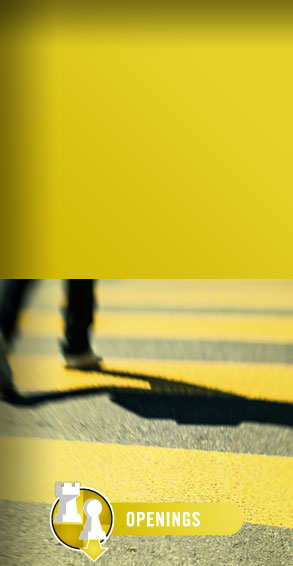Boris Gelfand is back – Part II
By Shay Bushinsky / photos by Shulamit Bushinsky
This is the second part of my interview with Boris Gelfand, which contains
some interesting professional insights made by the challenger and some comments
about the prospective world championship match against Anand. Part
one appeared here.
Q: It was interesting to observe your black opening strategy –
you deserted your unbeatable Petroff Defense for the Sicilian Najdorf, which
you used very effectively…
A: If you prepare well, you can play any opening. In this case I looked at
the field and I decided that the Sicilian would fit me better. In general, I’m
equally happy to play both openings with black.

Do you think game three against Mamedyarov was the best game of your
career?
Probably one of the best. I had a few difficult moves to make, but the whole
concept was clear – ...Rc8 was the only helpful move because otherwise
I’m simply lost, as well as ...Bg6 instead of taking the rook.
 Black played 19...Rfc8
Black played 19...Rfc8 |
|
 Instead of 34...Bxh3 Gelfand played 34...Bg6
Instead of 34...Bxh3 Gelfand played 34...Bg6 |
The final position is really unbelievable: seven pawns versus one – Alex
Huzman [Gelfand’s long time second] told me about a game between Lutikov
and Taimanov in which a similar concept emerged, although Taimanov had less
pawns than I did – only five pawns versus one, and the game was not as
beautiful.
Only in the final moves this element appeared, while we played with this material
imbalance for quite a while. White lost the game on time, but I may offer a
beautiful continuation: 40.Bc1 Rb2! (I’m not sure I would play this move,
but it’s beautiful) 41.Bxb2 axb2 42.Bb1 Be5, to be followed by f5-f4,
and White is a rook and an exchange up, but Black’s pawns f5-f4 are moving
forward while White’s pieces are paralyzed!
20… Rxc3 is a thematic move – did you feel you were winning
at this point?
I felt a big advantage – it’s hard to say that it’s winning,
there are a lot of technical problems still to be solved, but I was really surprised
Mamedyarov allowed it. He had two alternative moves: 20.Bg5, which I considered
to be leading to a very complicated game, and 20.g4, which was shown by all
of the engines. It looks odd but difficult to refute – surely it is better
than 20.Kh1 as played – because after I took on c3 White’s attack
was over. It is interesting to note the placing the bishop on b3, for the purpose
of pressing e6 and joining the attack – that is Fischer’s Sozin
Attack, a system I had a lot of experience with, played it maybe five times
against Kasparov… The problem with this placement is that once the attack
disappears the bishop becomes the weakest piece in White’s camp. So the
Sozin is very risky strategically: White goes all-in, but if the attack doesn’t
succeed then it’s over for him…
Didn’t you panic, seeing the heavy pieces mounting against
your king and the bishop hitting your f6 protector knight? You found the right
rook maneuver allowing a flight square for your king to slip away…
It’s true of course it’s scary, but when you have to make only
moves it’s easier. In fact, if it had been a choice it would’ve
been very hard to find…
This is an interesting element in chess, where one side forces the
other to make only moves, which turn very effective against the forcing side...
Indeed, sometimes it is better not to force moves because many tend to find
the right ones while when the same players have to take decisions, they are
more likely to make mistakes…
Were you surprised with Kamsky’s openings play?
Yes, he has caught up with his openings, thanks to his seconds, grandmasters
Sutovsky and Volokitin. He played very well. Sutovsky covered the Grünfeld
Defense as a great specialist, and Volokitin was coming up with good ideas for
White. So he was well prepared…
You were very lucky in game three against Kamsky. Weren’t you
lost if he'd played 29.Bxc4? Later on you yourself missed a win…?
Yes it’s true, I was lost for a couple of moves. I saw it and it was
very bad for me… Prior to that, I was playing only moves – luckily
his position looked so good to him that he played 29.Qh1 instead… Later,
having no time, I missed a win myself, overlooking 38…Qh5 walking out
of the pin and winning. But it’s a kind of move you need time for to calculate.
This was a very rocky game for both of us.
What happened in the playoffs? Extraordinarily in game three you
lost your queen…
It was the worst tie-break I ever played in my entire career – and I
have played dozens of them. I played the first two games awfully, I had a very
bad "day in the office". It could have been extremely costly. Nobody
is perfect, it was a long tournament. I didn’t take a full piece in the
second rapid game, so probably it was also not a great day for my opponent either…

Boris Gelfand plays the fatal move 16.a3?? and immediately realizes...

... that he has blundered. Gata Kamsky, of course, finds the refutation
The loss put you in a must-win situation in the fourth. How did
you manage to win this game?
Kamsky played an open game – some players would’ve tried to play
the Mohrinio style, but he has respect for himself as a player, so he decided
to play this game for a victory. He selected a double-edged complicated Open
Sicilian and then, at a certain move, he was about to blunder, to make a move
that loses in two, but didn’t do it, and then I tried to force matters
and blundered with 25.Bxf7. I was looking for complications – I played
a positionally good move which failed due to simple tactics… After he
missed it, my position was better and I played the rest of the game without
giving him a chance.
Kamsky went down in the blitz games…
I sympathize with him. It is very difficult to recover after being so close
to qualifying and losing. The blitz started really a short time after that dramatic
game four, which made it almost impossible for him…
And if it were you in his situation?
I don’t know… It happened to me in Khanty-Mansiysk a few times,
for example against Dreev, who made a comeback, and yet I managed somehow to
win. But you cannot compare situations. One tries to disassociate oneself and
play every game as a new game. it’s not easy, you can never be perfectly
focused…
Do you find yourself analyzing your previous games during games?
No, no! And my seconds never tell me anything about what came up from my previous
games analysis during the tournament…

What do you usually do during the games – you are known to
be pacing a lot – do you look at other games?
I go to the special side room for players – have a tea or a coffee, fruit
or some snacks [Gelfand returned very slim despite this activity].
I watch my game through the big monitor and wait for my opponent to make a move.
Sometimes I peek at interesting positions in other games, but it is always brief
and I never form opinions about them for the public…
Even when the pace of your game is slow and the lines are well known
– do you force yourself to analyze and “kill yourself” over
your position?
You need to find a balance – sometimes you need be very precise, especially
when a long line starts in your game, and try to foresee how the position will
look in 5-7 moves. But sometimes the moves are natural, so you simply check
if there is no move which is clearly better. Each position is different, so
it’s hard to specify a rule here. In cases where there is a choice between
two possibilities you have to hesitate and decide between them. During my opponents
moves I tend to check the line I chose and try to verify that I didn’t
miss anything. Nowadays I try more to work on my opponent’s time –
in the past I was wasting this time…
– End of part two –
 |
About the author
Shay Bushinsky is a computer scientist and the co-author of Deep Junior,
5 times world computer chess champion. He teaches Artificial Intelligence
in Tel-Aviv and Haifa Universities Computer Science departments.
Until recently, Shay was the Chief Technology Officer of IST, a spin-off
company of Logic LTD. developing AI applications in the field of Natural
Language Processing. Shay is currently initiating a startup company based
on new ideas in this field.
Interview
and pictures:
copyright Bushinsky/ChessBase |
























